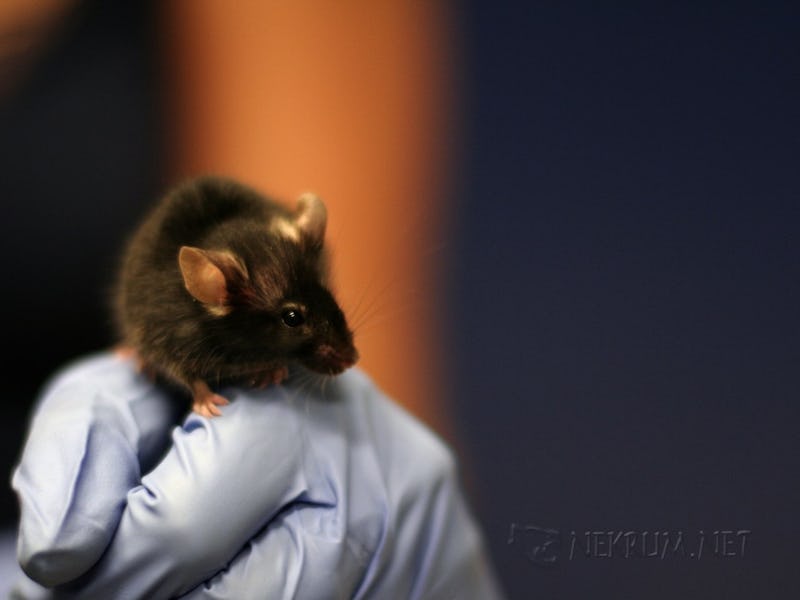How Many Lab Mice Did American Researchers Kill in 2015?
Congress has made doing the calculation almost impossible, and that's a problem.

It’s year-end season and that means roundups, as in “Most Amazing New Discoveries of 2015” and “The People We Lost in 2015.” There’s nothing wrong with this media tradition: It’s important to track both the discoveries we make and the people we lose, but it’s also easy to forget that loss and progress are intertwined. Here’s a fact: Between 10 million to 100 million mice and rats were killed in the name of American science in 2015. We know the order of magnitude, but getting near the number is downright impossible. We cannot create a listicle for the dead.
Mice and rats are great organisms to study in labs: They’re cheap, easy to breed, and mammalian. We need them for basic science and we have an obligation to protect them from undue suffering, something we do with federal regulations and institutional oversight. (The most important of these is the Institutional Animal Care and Use Committees, which reviews proposed experiments with the goal of reducing, refining, and replacing live animals.) Given IACUCs and the like, you’d think there would be a better way to accurately estimate the number of dead mice, but there’s a gigantic loophole in the system.
Let’s examine how the Animal Welfare Act defines a vertebrate.
In every other realm — biology class, say, or reality — a vertebrate is an organism with a spinal column that terminates in a skull containing cranial tissue. This is simple stuff. The Animal Welfare Act, created in response to investigations of dognapped pets who ended up dead in hospital experiments, has other ideas. Thanks to a 2002 amendment, mice, birds, and rats can’t stand up and be counted among the backboned animals under the AWA.
That raises some transparency issues, and is a foil that animal-welfare groups like PETA wield well. By FOIAing the National Institutes of Health regarding the number of lab animals and publishing the result in the Journal of Medical Ethics, the organization brought the issue of unquantifiable death to the fore. Even those who are fine with laboratory testing of mice and the killing of some animals in the name of research, would likely agree that it behooves humanity to keep count.
On the academic and lab-supply industry side, the estimates are, as you might surmise, a bit more conservative. A representative for the nonprofit Jackson Laboratory, a key supplier of cancer research mice based in Bar Harbor, Maine, tells Inverse that, “to my knowledge no one has answered it definitively.” Jackson delivers on the order of 2.5 million mice globally. “But we really can’t speak for the big picture,” the rep said. “We don’t know how many mice come from the for-profit vendors such as Charles River, and it’s impossible to estimate how many mice are maintained in labs in, say, China.”
There is nothing fishy about Jackson Laboratory as a part of the scientific community or as a business except this: They don’t know they size of the market they operate in. Go to a place like John’s Hopkins University and ask about mice, depending on who you ask, you might get an estimate of 20 million to 30 million mice dead mice. That would indicate a downright unnerving national death count.
Compounding the problem is if you count the rodents born in labs — those can be killed without being used in an experiment, as Western Carolina University psychologist Hal Herzog notes in the Huffington Post, and never accounted for — the picture is even murkier. The number keeps creeping higher.
From an ethical standpoint, there is a historical argument that goes something like this: A mouse’s life isn’t worthless and a human life isn’t worth everything, so there must be a number of mouse lives that equal the value of a human life. This is both reductive and illustrative reasoning. The death of a single mouse represents a loss, but not a significant one from a human perspective. But tens of millions of lives, well, at some point we’re not just talking about a moral rounding error. Again, this doesn’t mean that those lives weren’t given the name of something worthwhile, just that we’re shirking our responsibility by failing to do the morbid math. Just because we couldn’t do those calculations scientifically, doesn’t mean we should cop out utterly.
Extrapolating the data from the PETA study, however, gives us about 86 million annual mice and rats, a guess that Herzog believes is closest. Until Congress reevaluates what it means to be a vertebrate, however, this will be the one hypothesis we can’t test using mice.